Birkenhead Corporation Tramways
History
The predecessor to Birkenhead Corporation — the Birkenhead Improvement Commissioners — became a tramway owner on the 21st November 1864, when it leased its newly built standard-gauge tracks at Woodside Ferry to the Birkenhead Street Railway Company; these tracks effectively formed a short extension to the BSRCo's main line, but nevertheless, they made Birkenhead the first local authority in the British Isles to own a tramway. The process was repeated on the 6th September 1873, this time connecting to the Hoylake and Birkenhead Rail and Tramway Company's line, and once again on the 19th January 1878 to the Wirral Tramway Company's New Ferry route.
Birkenhead was incorporated as a County Borough by Royal Charter on the 13th August 1877, a year that also saw the formation of a new tramway company — the Birkenhead Tramways Company — which acquired the Birkenhead Street Railway Company, and on the 12th October 1879, the Hoylake and Birkenhead Rail and Tramway Company's 'Docks' line. The latter, however, was to have serious consequences for the company, as competition from the Mersey Railway Company, as a result of the opening of its tunnel under the Mersey, led to a dramatic fall in passenger numbers, and ultimately, liquidation. The tramway system was, however, rescued by a combination of the corporation, which bought the BTCo's tracks (circa 6.3 miles), and a new company — the Birkenhead United Tramway, Omnibus and Carriage Company Limited — which took over operation, as the lessee of the corporation, on the 15th August 1890.
Birkenhead's other tramway, the Wirral Tramway Company, whilst less affected initially, also felt the cold winds of competition, and on the 11th March 1895, the corporation once again stepped in, purchasing the latter's tracks (circa 3 miles) and granting them a 21-year lease. This proved to be a less-than judicious move, as the WTCo's tracks required renewal, and less than five years later, the corporation would have to put its hand in its pocket once again, this time to buy the WTCo out of the ridiculously long lease.
By the mid 1890s the corporation was giving serious consideration to conversion of its horse lines to electric traction, and thereafter, operating the system as a municipal concern. With this in mind, the company sought powers to operate the tramways, and to use mechanical traction, including electric; these were granted on the 15th July 1897 under the Birkenhead Corporation Act (1897). Following much discussion, the council formally decided to proceed with the creation of a municipally operated electric tramway system in May 1898. Further powers were subsequently sought, firstly to buy the WTCo out of its lease (with termination set for the 31st December 1899), and secondly, to build an additional nine miles of tramway; these were granted on the 20th June 1899 under the Birkenhead Corporation Act (1899).
Following expiry of the WTCo's lease, the company was allowed to continue running horse-drawn services until such time as the line (to New Ferry) was ready for reconstruction; however, as the time for electrification drew near, agreement on the finer details of the operational arrangement could not be reached, the WTCo summarily announcing that it would discontinue services, which it did on the 8th May 1900. This resulted in new business coming the way of the BUTO&CCo, which the corporation asked to provide a replacement tram service on the New Ferry route, services recommencing on the route on the 16th May 1900.
Meanwhile, the BUTO&CCo continued to operate horse-drawn services over the former BTCo lines, ahead of the expiry of its own lease on the 31st December 1900. Once again, the corporation and the company agreed that services would be continued beyond the expiry of the lease, only ceasing as and when reconstruction for overhead electric working necessitated it.
The last horse-tram service over the tracks of the former WTCo ran on the 22nd January 1901, the replacement electric services commencing just two weeks later on the 4th February 1901. As reconstruction proceeded on the other routes, the horse tramway services were gradually wound down, the last of all, operated by the BUTO&CCo, running on the 8th November 1901.
At its maximum, the standard-gauge horse tramway system owned by the corporation had totalled around 9.3 miles. However, not all the old horse-tramway lines were rebuilt for electric working, some stretches being abandoned, whilst new electric lines were built our to areas previously unserved by the horse tramways.
Following the opening of the New Ferry route, it became clear that the corporation had significantly misjudged the potential traffic, many trams being full as they left the terminus, passengers at subsequent stops having little chance of finding a seat or even a place to stand. Unfortunately, the corporation's hands were tied, as it had built the New Ferry line, as well as others that were in the process of being constructed, on the single line and loop principal, which greatly constrained the number of tramcars that could be run. Following the appointment of an experienced manager, the corporation had to hurriedly replan the system, converting as much as possible to double-track formation, which had a much higher capacity.
The overhead electric system opened in stages between the 4th February 1901 and the 2nd March 1902, though it took several years more to reconstruct lines to double-track formation. The lack of capacity had unforeseen consequences in 1905 when, on the 9th December, the system began to suffer motorbus competition, the Mersey Railway Company having lost patience with the corporation's inability to provide a proper tram service to and from Birkenhead Central Station. The corporation fought a long legal action against the railway company, finally bringing a halt to the motorbuses on the 8th July 1907 following a House of Lords decision.
The standard-gauge, overhead electric system reached its maximum extent of 13.75 miles in 1909 with the opening of a short connecting line along Market Place South. From Woodside Ferry, lines radiated: northwestwards (via Cleveland Street and Beaufort Road) to a terminus outside the Graving Dock Hotel near Birkenhead North Station; northwestwards (via Conway Street and Park Road North) to a terminus n Laird Street near its junction with Plumer Street; southwestwards (via Borough Road and Prenton Road West) to a terminus just short of Stourton Road in Prenton; westwards (via Claughton Road and Park Road South) to a terminus in Egerton Road, Claughton; southwards (via Argyle Street South, Pearson Road and Church Road) to a terminus in Bebington Road, Tranmere; southeastwards (via Chester Street, Chester Road and New Chester Road) to a terminus at the latter's junction with New Ferry Road in New Ferry. A circular route branched off the Prenton line in Borough Road, running westwards along Balls Road East and Shrewsbury Road to Oxton, continuing northwards along Shrewsbury Road North to Claughton Village, then northeastwards along Park Road North to join the Laird Street line. Operational flexibility was conferred by a number of short connecting lines, particularly in the town centre (Argyle Street, Hamilton Street and Hamilton Square).
The system was operated by 60 tramcars, delivered in 1901 and 1902, which were joined by six more in 1913.
The corporation was relatively forward thinking in respect of motorbus operation, obtaining powers to run motorbuses — both inside the municipal boundary and on six routes outside — on the 31st July 1914, under the Birkenhead Corporation Act (1914); however, before a service could be run, the Great War intervened, stopping any further implementation.
Like most systems, Birkenhead's was heavily impacted by the Great War, losing staff and their skills to the armed services, and facing severe restrictions on spares and new materials, all whilst having to manage greatly increased loadings, which reached a peak of 24 million in 1918/19. Although some rail replacement went ahead in 1915, the war was inevitably a time of minimal maintenance, the system emerging from the conflict in a run-down condition. The corporation, however, clearly saw its tramway system as central to public transport provision, authorising expenditure on tramcar refurbishment, despite the high costs of the immediate post-war years. This was followed by a major programme of track replacement — authorised on the 14th December 1921 — that proceeded throughout the 1920s, only being completed in 1929.
The corporation's thoughts also quickly returned to motorbus operation, and it lost no time in procuring new vehicles, commencing its first motorbus service on the 12th July 1919. The motorbus operations were from the start planned with the tramway in mind, acting as feeders to the latter, or as extensions to villages where a tramway could not be justified. Despite the success of motorbus operation, the corporation was still actively considering extensions to the tramway in 1921 and 1922, and obtained powers to build a short extension connecting the Laird Street line to the Docks line (Beaufort Road) — on the 31st July 1923 under the Birkenhead Corporation Act (1923) — this was, however, not built.
In 1925, the corporation took the decision to rid itself of the loss-making Claughton Road tramway line, replacing the trams with a motorbus service on the 30th August 1925, the last tram running the day before. By this time, the corporation's motorbuses numbered around 40, and were delivering services both within and outside the borough, as well as joint services with Wallasey Corporation; further expansion was, however, hindered by the objections of Crossville Motor Services, which already operated outside the borough, and whose attempts to enter the borough were repeatedly blocked by the corporation.
Despite the closure of the Claughton Road line, the tramway remained central to the corporation's thinking, with investment in tramcar refurbishment continuing. There was, however, no denying the success of the motorbus operations, which by 1929, were carrying a million more passengers than the tramway; this was in stark contrast to many other municipal operators' experiences with motorbuses, and was almost certainly due to the clarity of thinking around route development within the department. This was no accident, the whole tramway system having been very well run, and very profitable, once the initial difficulties had been overcome.
The corporation finally reached a compromise with Crossville Motor Services in June 1930, agreeing to allow the company to run through to Woodside (from various directions) in return for dropping objections to the running of corporation buses to several new destinations outside the borough. Although this was not accompanied by an official decision to abandon the tramway, the department must have been fully aware of the likely consequences, as Crossville buses would not now unload and load passengers at the tram termini, but would instead carry them straight through. An indication of the thinking within the corporation can be gleaned from the Birkenhead Corporation Act (1930), which received its Royal Assent on the 4th June 1930, and which granted powers to the corporation to run trolleybuses, both in addition to, but also as replacements for, tramway services. Although these powers were not used, the corporation was clearly preparing the way for the tramway's abandonment.
The first part of the Crossville agreement was implemented on the 1st August 1930, the old tramcars on the New Ferry line succumbing 16 months later on the 27th December 1931. The remaining lines lasted a little longer, the trams to Tranmere running for the last time on the 29th September 1934, those to Prenton on the 30th September 1934, and those over the Docks line to Birkenhead North on the 31st March 1935, a year which also saw the undertaking change its name to Birkenhead Corporation Transport.
The remainder of the system, essentially the circular route via Oxton and Claughton Village, was closed two years later, the last trams running on 17th July 1937.
Uniforms
Early photographs — and an article from Tramway and Railway World (1901) — reveal that tramcar crews were initially issued with smart double-breasted, lancer-style tunics (made from heavy blue serge) with five pairs of buttons (in 'German silver' and narrowing from top to bottom; see link) and stand-up collars. The collars, cuffs and trouser seams were all piped in scarlet cloth, with the cuffs faced in leather. The collars carried individual nickel initials on the right-hand side — 'B C T' — and an employee number on the left-hand side. The piped, drooping-peak caps, bore a small, municipal-device badge, which was worn above a script-lettering grade badge, either 'Driver' or 'Conductor'; all the insignia were nickel. The Tramway and Railway World article makes great play of the fact that the double-breasted tunics were designed to be worn 'buttoned up', obviating the need for collars and ties, and thus guaranteeing a smart, tidy appearance.
At some point, probably in the mid-to-late-Edwardian era, the rather dated drooping-peak caps gave way to more modern tensioned-crown peaked caps; these continued to carry the same insignia as previously. Shortly before the tramway closed, the cap badge arrangement (a small municipal-device badge and a grade badge) was changed in favour a large nickel municipal-device badge, roughly four-times the size of its predecessor.
No change was made to the general style of the uniform until very late in the tramway's life, at which time a switch was made to double-breasted jackets with lapels, which were distinctly naval in appearance. It is uncertain when this change was made, as the vast majority of surviving photographs show tramcar crews in long, double-breasted greatcoats (with lapels). Other than the five pairs of buttons, these latter garments appear to have been devoid of insignia.
Photographs of inspectors are rare, and the one example known to me (from 1913) indicates that they wore typical tramway inspector garb, namely: single-breasted jackets with hidden buttons (or more likely with hook and eye fasteners), edged in a finer material than the main jacket, and with stand-up collars; the latter carried the designation 'Inspector'; it is however unclear whether these were metal badges or embroidered. It seems likely that the styles of cap mirrored those issued to tramcar crews, which by 1913 were of the tensioned-crown peaked type; the latter caps bore the grade — 'Inspector' — in embroidered script lettering on a brocade hat band, above which a small municipal-device badge was worn.
As with many tramway systems, women were employed in significant numbers during the Great War to replace male staff lost to the armed forces. The first women were employed as conductresses (six started on 13th September 1915) and by 1917, this had risen to eighty-four, virtually the entire conducting staff. Although six women were employed as ticket inspectresses, they appear never to have served as motorwomen. Precise details of the uniforms are unclear, though long, single-breasted, tailored coats were certainly worn, together with wide-crown peaked caps; the latter bore the standard cap insignia.
Further reading
For a full history of Birkenhead Corporation Tramways, see: 'The Tramways of Birkenhead and Wallasey' by T B Maund and M Jenkins; LRTA (1987).
Images
Motormen and conductors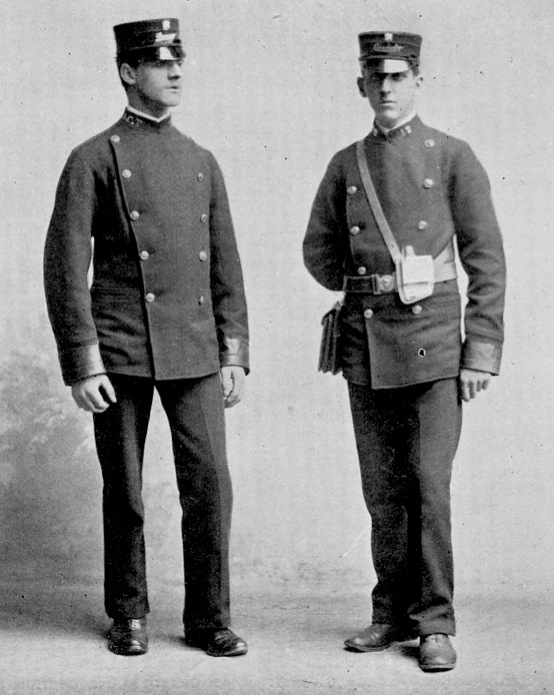
A commercial portrait of a Birkenhead motorman (driver) and a conductor (No 17). Both men are wearing lancer-style tunics with drooping-peak caps. The above photo comes from a short article, presumably paid for by the uniform manufacturers (Messrs Pearson, Huggins and Co, 51 Scrutton St, Finsbury, E.C), in Tramway and Railway World, 1901. With thanks to David Voice.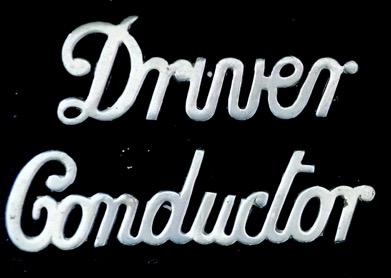
Standard script-lettering grade badges of the type used by Birkenhead Corporation Tramways on tramcar crew caps — nickel.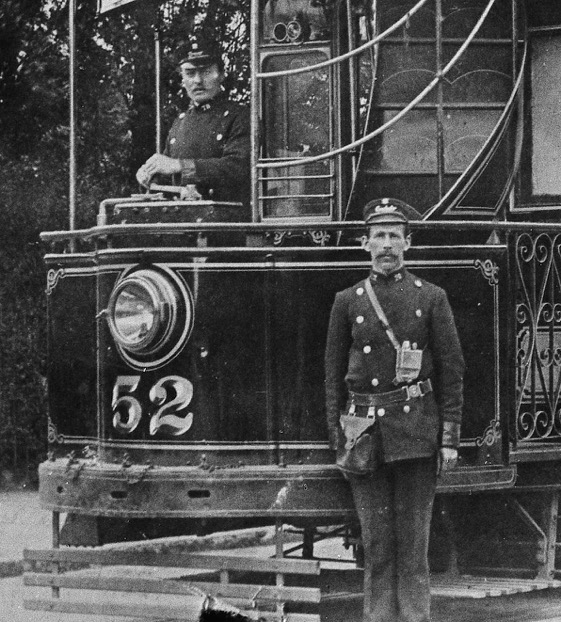
A motorman and a conductor with what appears to be a newly outshopped and top-covered No 52, dating the photograph to the summer 1904. Photo courtesy of the National Tramway Museum.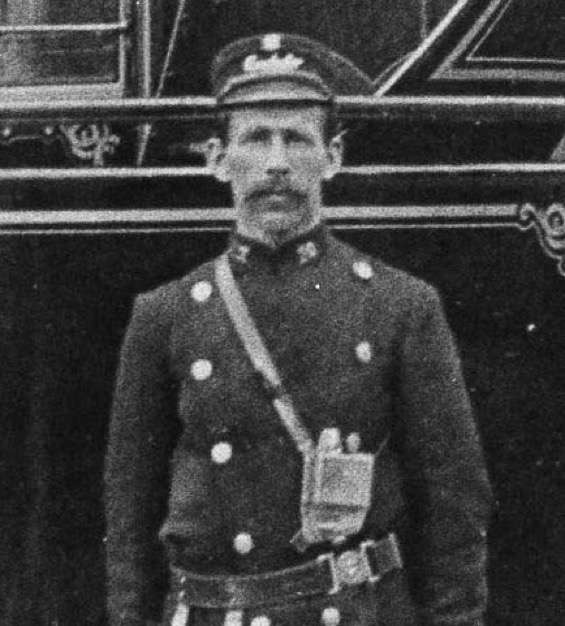
An enlargement of the above photograph showing details of the conductor's uniform, including what appears to be an officially issued belt, something of a rarity for a UK tramway system.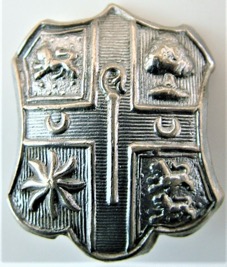
Birkenhead Corporation Tramways municipal-device cap badge — nickel. Photo courtesy of Dave Wilkinson.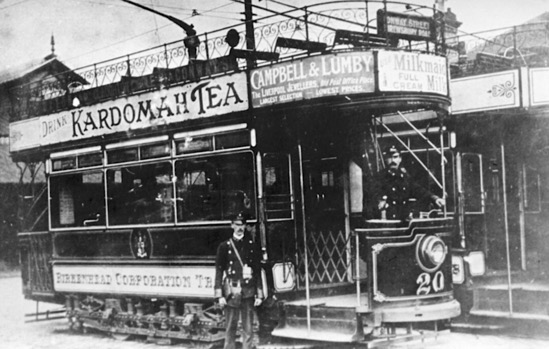
A conductor and a motorman pose with Tramcar No 20 at Woodside — photo undated, but certainly taken before 1910 when this car was fitted with a top cover. Photo courtesy of the Tramways and Light Railway Society, with thanks to David Voice.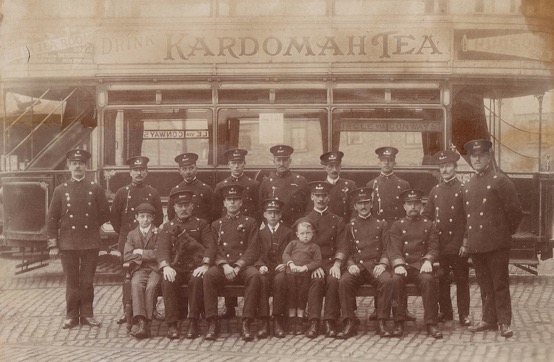
A depot photograph showing a rather informal grouping of motormen and conductors. The photograph is undated, though the general feel is mid-to-late Edwardian. The tramcar in the background is one of the G F Milnes-bulit 14-44 series, which carries a top cover, making it either No 16 or No 17; these vehicles were top-covered in 1903, so the photograph was certainly taken no earlier than this. Author's Collection.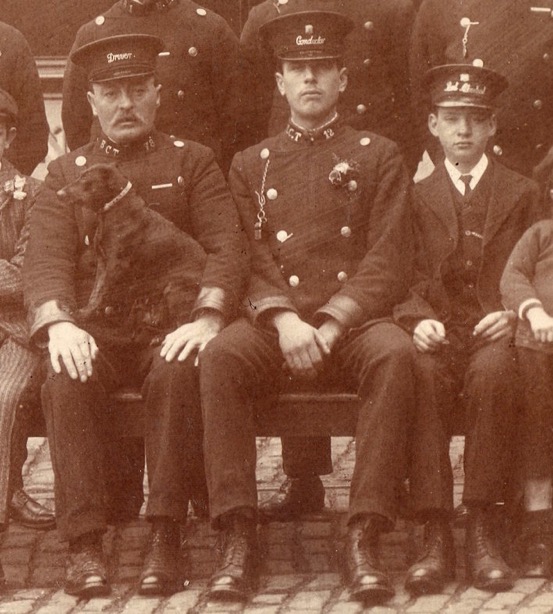
An enlargement of the above photograph showing a motorman (Employee No 78) with his dog, a conductor (Employee No 12), and a smartly dressed youth; it is unclear what position the latter holds, as his two-piece grade badge is indecipherable; obvious candidates are 'Points Boy' or 'Parcels Boy'. Although the style of uniform is unchanged from that first issued, the caps had by this time clearly been superseded by a more modern tensioned-crown type.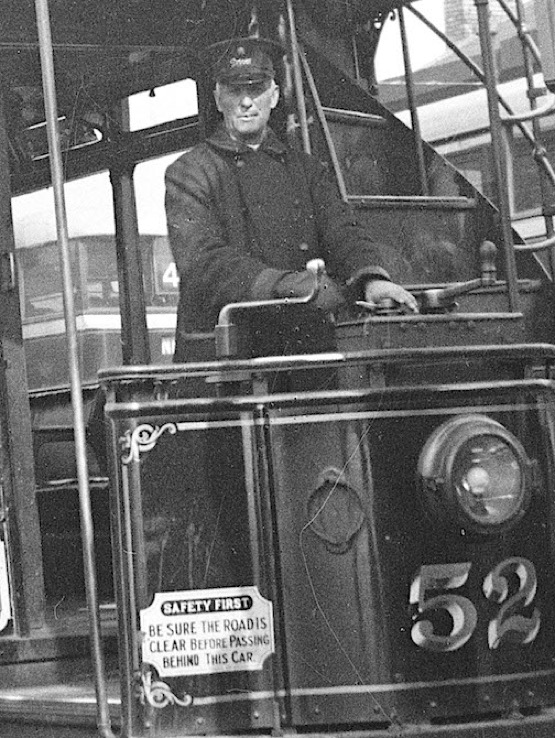
A motorman at the controls of Tramcar No 52 in 1932. Photo by M J O'Connor, courtesy of the National Tramway Museum.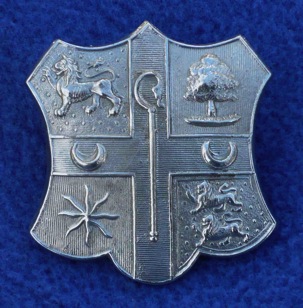
A large municipal-device cap badge of the type worn by tramways staff shortly before closure — chrome. This badge is roughly four times the surface area of its predecessor.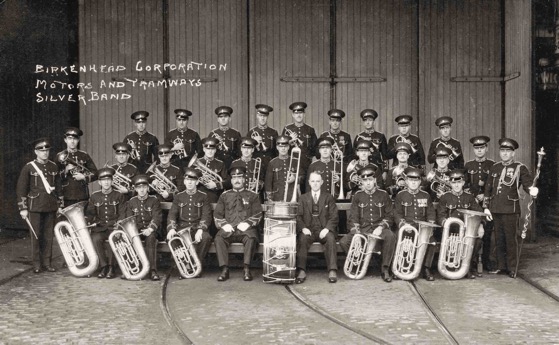
Birkenhead Corporation Motors and Tramways Silver Band — photo undated, but probably taken in the late 1920s or early 1930s. Photo courtesy of Gavin Holman.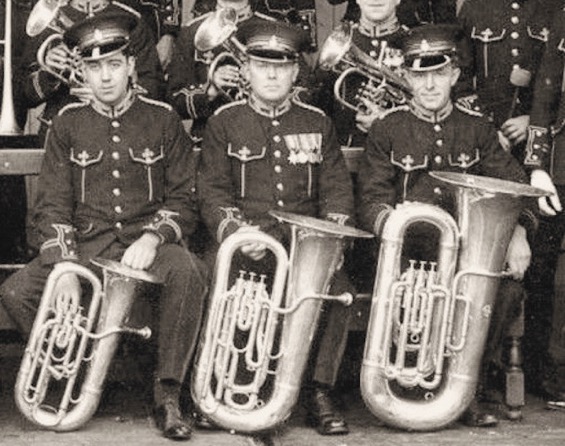
An enlargement of the above photograph showing three of the bandsmen. Unlike the majority of tramway bands, the men are wearing bespoke uniforms, heavily embellished with cording and piping, all in a much lighter colour than the main body of the tunic. The caps bear a striped hat band, no doubt also in a contrasting colour, along with what is probably a bespoke cap badge.
Senior staff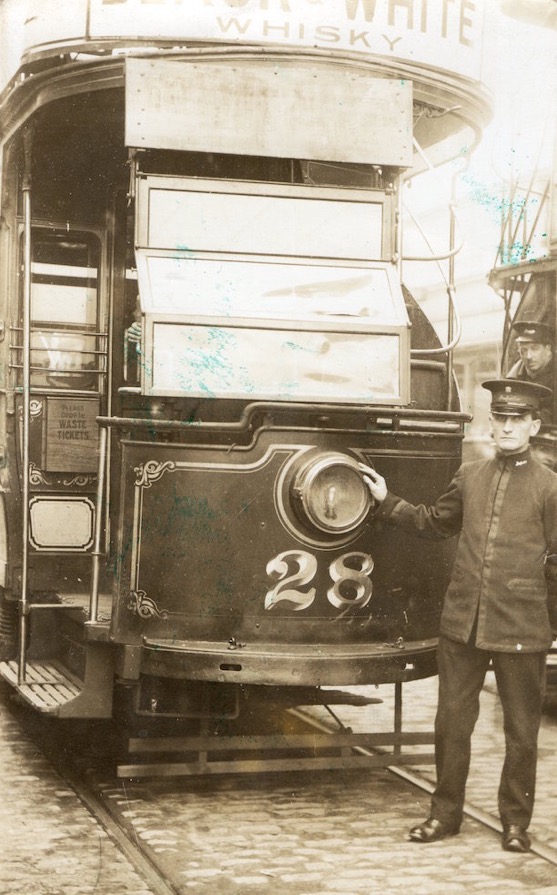
A Birkenhead Corporation Tramways inspector poses for what is presumably a press shot in 1913 with Tramcar No 28, newly fitted with a rather Heath Robinson-looking folding windscreen Author's Collection.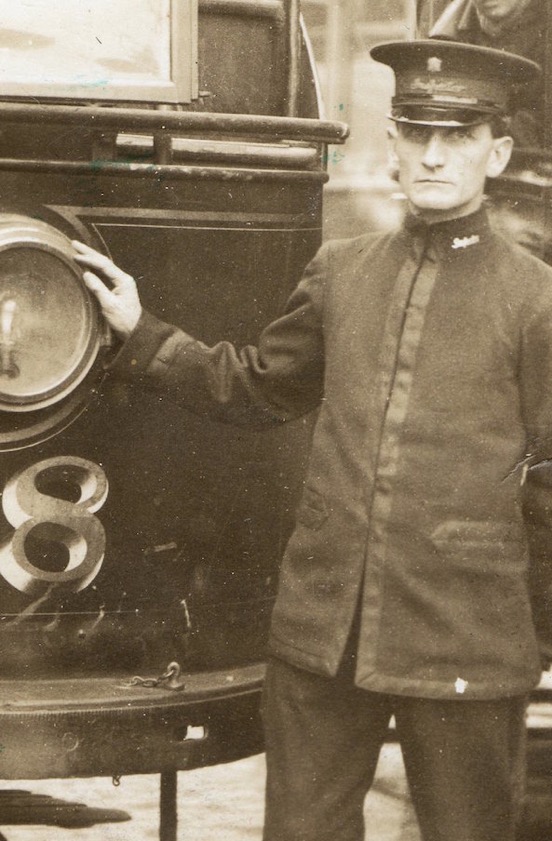
An enlargement of the above photograph showing the inspector, whose uniform is typical of tramway practice at this time.
Female staff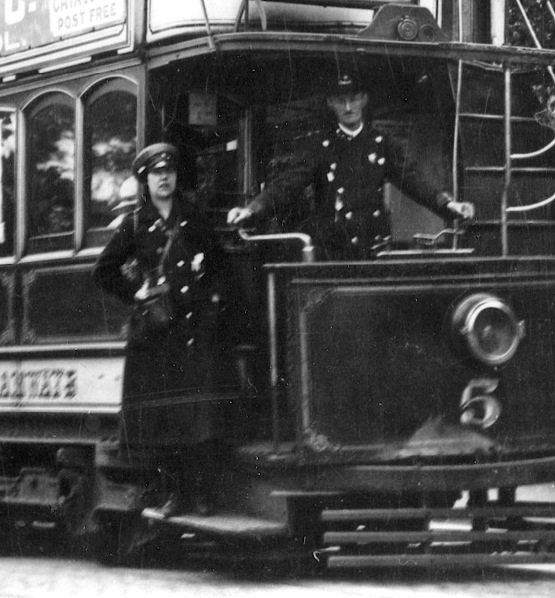
A rare photograph showing a Birkenhead conductress, aboard Tramcar No 5 — photo undated, but almost certainly taken during the Great War. Author's Collection.